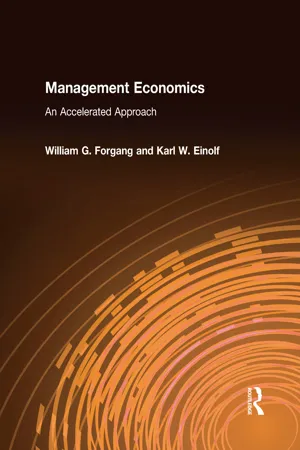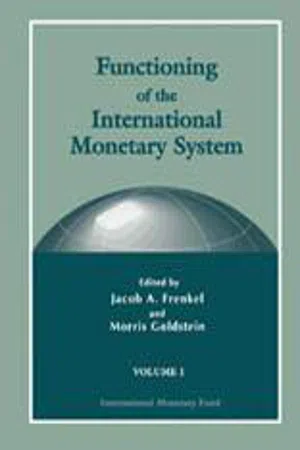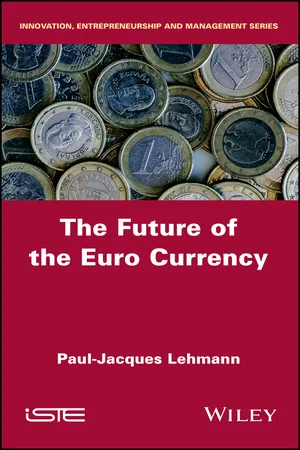Economics
Europe Money Supply
Europe money supply refers to the total amount of money in circulation within the European economy. It includes currency, demand deposits, and other liquid assets held by individuals and businesses. The European Central Bank closely monitors and manages the money supply to maintain price stability and support economic growth.
Written by Perlego with AI-assistance
Related key terms
4 Key excerpts on "Europe Money Supply"
- eBook - ePub
Management Economics: An Accelerated Approach
An Accelerated Approach
- William G. Forgang, Karl W. Einolf(Authors)
- 2015(Publication Date)
- Routledge(Publisher)
a medium of exchange. The unit of account function means that goods and services are priced in money terms. The medium of exchange function means that goods and services are exchanged for money.Application Box 3.6The nation’s money supply (M1) in November 2005 was $1,372 billion.Source: www.economagic.com.Therefore, one component of the money supply is currency and coins. However, many purchases are completed by writing checks, and dollar balances in checking accounts (demand deposits) are the largest part of the money supply. Checking deposits and currency and coin are the largest components of the M1 definition of money.The Equation of ExchangeOne way to examine the relationship between the money supply and gross domestic product is through the equation of exchange (see Table 3.1 ).The equation of exchange is an identity. On the left side of the equation, the supply of money (M ) is multiplied by the velocity of money (V ). The velocity of money is the average number of times a dollar or deposit is used to complete transactions during a year. For example, assume individuals are paid weekly and spend the full amount before their next pay period. Under these restrictive assumptions, the velocity of money is 52. If individuals are paid monthly and spend the full amount on goods and services prior to the next pay period, the velocity is 12.Table 3.1 Equation of ExchangeMV = PT Where: M = money supply V = velocity of money P = price level T = number of transactions The left side of the equation of exchange is total expenditures. It is the money supply multiplied by the velocity. The right side of the equation is total receipts , which are the average price of goods and services (P ) multiplied by the number of transactions (T - eBook - ePub
- Wim Hulleman, Ad Marijs(Authors)
- 2021(Publication Date)
- Routledge(Publisher)
The first pillar of the ECB’s monetary policy presupposes that M3 is a reliable leading indicator for medium-term price development. The quantity theory easily demonstrates this. An increase in the money supply will of necessity lead to price increases if the velocity of circulation and the production remain the same. If the public has increasing amounts of money at its disposal, there is a good chance that they will be used for purchasing goods and services. This causes expenditure to increase – assuming that the production remains constant – and this will cause a price increase. Put simply, inflation is the result of too much money chasing too few goods.Headquarters of the ECB in FrankfurtSource: website ECB (new premises media centre)Reference value for M3The ECB publishes an annual reference value for M3. This represents the growth ratio of money that is compatible with medium-term price stability. The ECB uses the quantity theory to determine the reference value for M3 (see figure 7.9 ).FIGURE 7.9Determining the reference value of M3The European Central Bank looks first at the increase in the amount of money that is necessary to finance trend-related growth in production. The ECB assumes that production (Q) in the eurozone grows yearly by 2% in line with the trend. At an admissible inflation of 2% yearly, the demand for money (PxQ) will increase by 4% per year (see Fig. 7.8 ). The amount of money (M) would also have to increase by 4% if it were not for the fact that the velocity of circulation changes too. Let us assume that the velocity of circulation in the eurozone (V) decreases by about 0.5% per year. When money does not go from hand to hand that fast anymore more money is needed to pay the same quantity products. The decrease in the velocity of circulation is compensated by the ECB, which determines the reference value for monetary growth not at 4% but at 4.5% per year.Actual growth of M3If the actual growth of M3 exceeds the reference value the ECB will scrutinise the causes carefully. If the ECB is of the opinion that exceeding the reference value is the result of an incidental increase in demand for idle cash it will not take any measures. After all, idle balances are not used for expenditure but are kept for investment purposes. If, however, the ECB is of the opinion that the public is using the increased amount of money for expenditure, it will take measures to prevent demand-pull inflation. - eBook - ePub
- Jacob Frenkel, and Morris Goldstein(Authors)
- 1996(Publication Date)
- INTERNATIONAL MONETARY FUND(Publisher)
European Monetary System, European Economic and Monetary Union, German Unification
Passage contains an image
6 Economic and Monetary Integration and the Aggregate Demand for Money in the EMS
JEROEN J.M. KREMERS and TIMOTHY D. LANE*This paper examines the determinants of the aggregate demand for narrow money (M1) in the countries participating in the exchange rate mechanism (ERM) of the European Monetary System (EMS).Aggregate demand for M1 in the countries participating in the exchange rate mechanism (ERM) of the European Monetary System is shown to be a stable function of ERM-wide income, inflation, interest rates, and the ECU-dollar exchange rate. Particularly noteworthy is the rapid dynamic adjustment, in contrast to the implausibly slow adjustment implied by most single-country estimates. These results, if robust, suggest that, even at the present stage of economic and monetary integration, a European central bank might be able to implement monetary control more effectively than the individual national central banks.The motivation for this study is twofold. First, the increasing degree of stability in exchange rates and the process of liberalizing capital movements within the ERM area are likely to have increased the substitutability of money and other assets denominated in the various participating currencies. As a result of this development and of the increased degree of integration of the ERM economies, the demand for money in individual countries may have become more volatile, while at the same time the demand for money in the ERM area as a whole may have become more stable. Russo and Tullio (1988) - eBook - ePub
- Paul-Jacques Lehmann(Author)
- 2019(Publication Date)
- Wiley-ISTE(Publisher)
The main body of the European System of Central Banks is the European Central Bank (ECB). Currently located in Frankfurt am Main, first in the Eurotower and, since 2014, in the Skytower, it has legal personality under international public law, while each National Central Bank has legal personality under the national law applicable in its country. At the end of 1999, the European Central Bank employed 732 people.It has a capital of €5 billion provided by national central banks of the 15 Member States, depending on the countries’ respective shares in the gross domestic product and population of the European Union. The 11 central banks making up the Eurosystem have fully paid up their subscriptions, while the four national central banks that do not participate in the euro have only paid up 5%, which means that the European Central Bank’s initial total effectively reaches just less than €4 billion. The majority of the European Central Bank’s own funds (capital and reserves) are invested in long-term securities denominated in euros.At the same time, the European Central Bank receives foreign exchange reserves from the national central banks (15% gold, 85% foreign exchange) of €39.5 billion from the €50 billion cap. These reserves, which represent 27% of the world total (compared to 61% for the dollar), should ensure that the Bank has sufficient liquidity at all times to carry out any necessary intervention in the foreign exchange market. In addition, these reserves are managed in a decentralized manner by the national central banks of the euro zone, with the objective of maximizing their value in accordance with the strategy defined by the European Central Bank.The ECB must submit an annual report on the activities of the ESCB and on monetary policy for the previous and current year to the European Parliament, the Council and the Commission. At least once a quarter, the President of the Bank is invited to answer questions from the European Parliament’s Committee on Economic and Monetary Affairs concerning the economic outlook and to justify the monetary policy conducted within the euro zone.The political institutions that influence monetary policy are:- – the Council of Ministers of Economy and Finance, Ecofin, which brings together the Ministers of Finance from all Member States of the European Union. It is empowered to take decisions, after consulting the European Central Bank, on the exchange rate policy of the euro with respect to the currencies of third countries;
Index pages curate the most relevant extracts from our library of academic textbooks. They’ve been created using an in-house natural language model (NLM), each adding context and meaning to key research topics.



